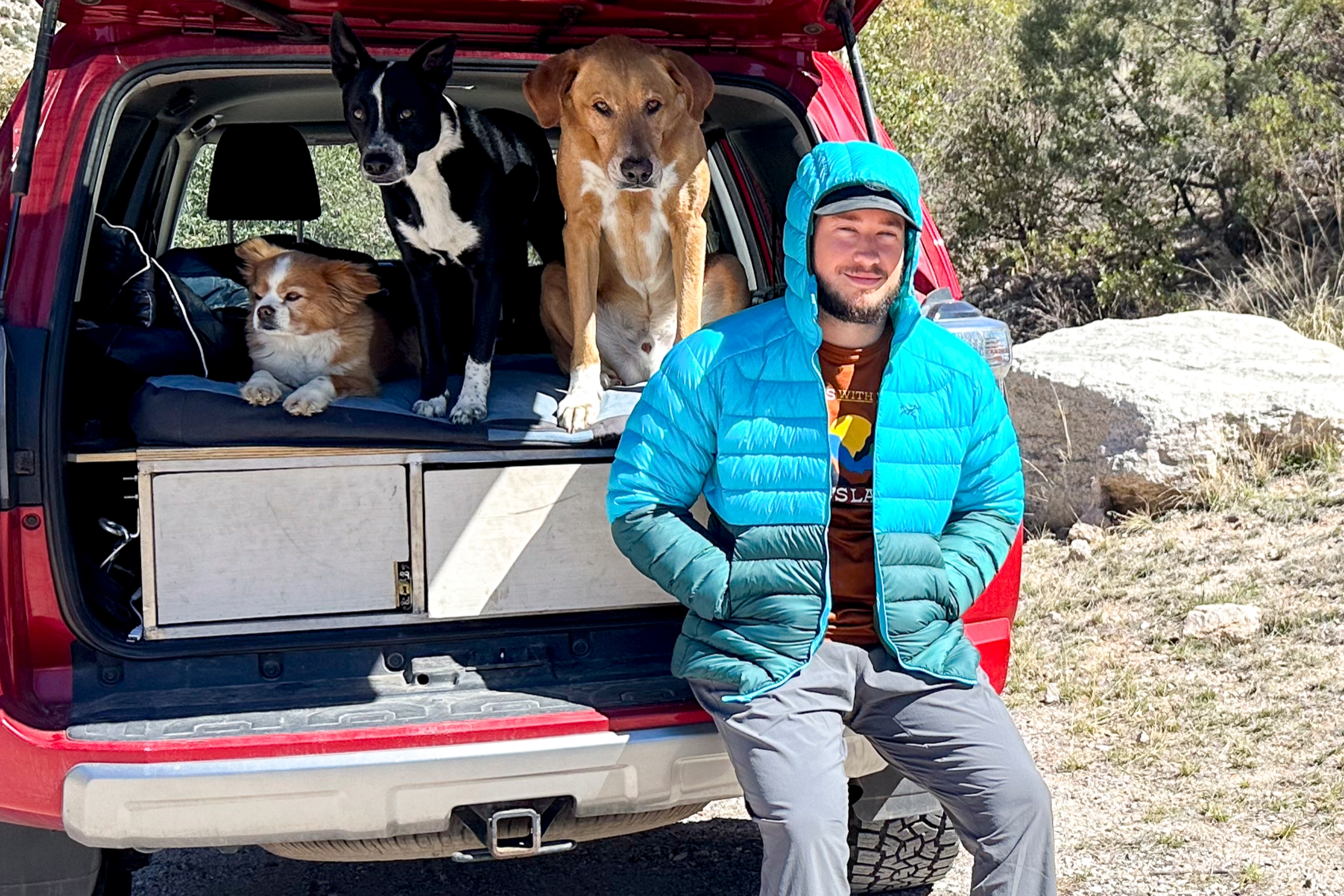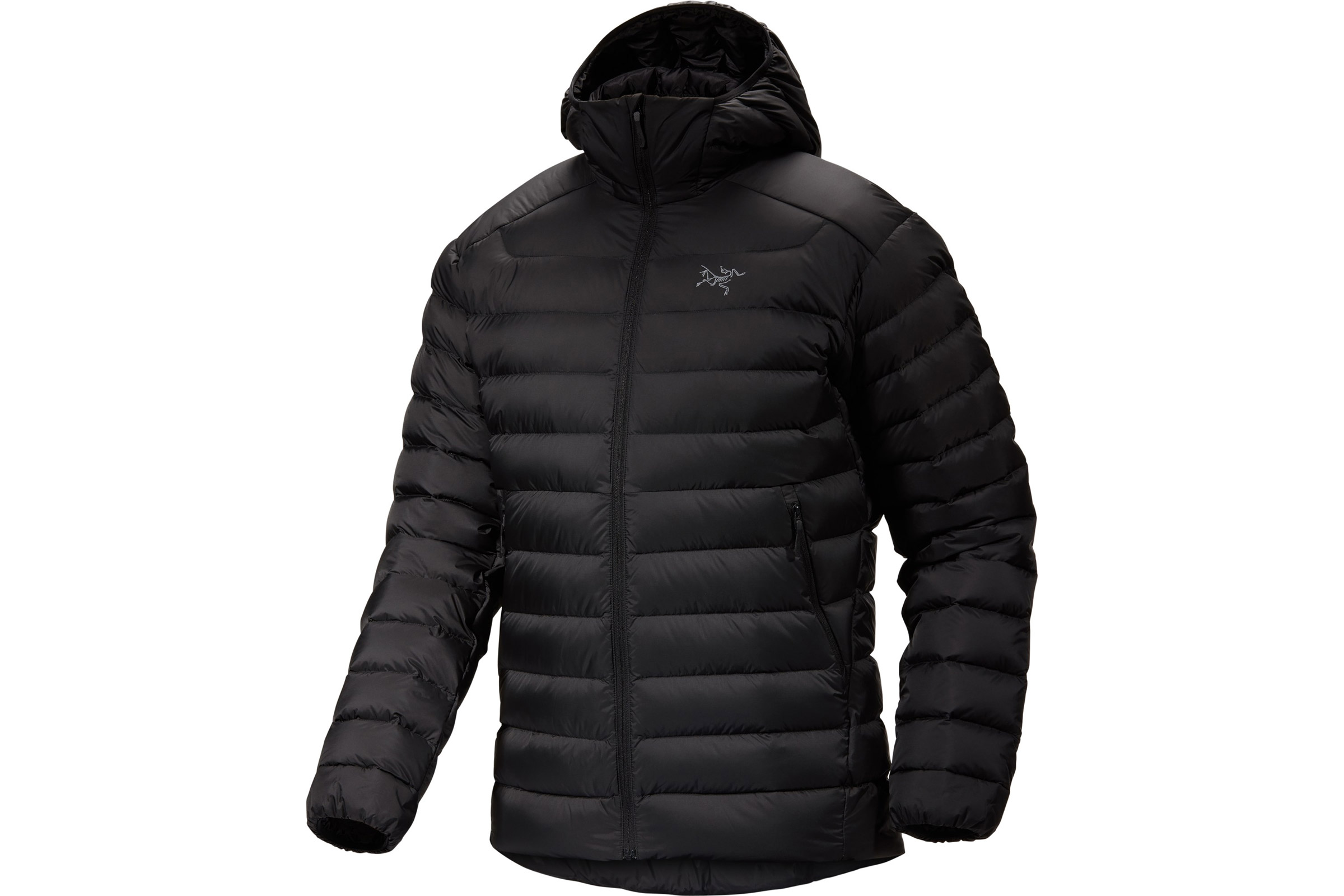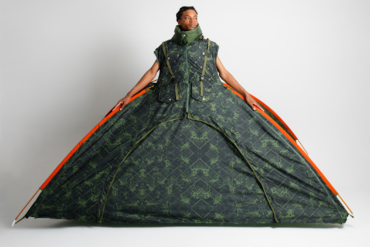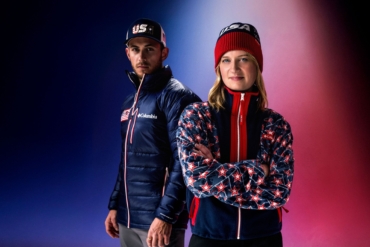Living in Tucson, Ariz., I was certain I’d have to drive north to Flagstaff or at the very least to the Catalina Mountains to properly test the Arc’teryx Cerium Hoody. Even in early January, Tucson rarely gets cold.
However, to my great luck (and many locals’ chagrin), we got a string of truly cold winter days that month. A bit of snow fell and we even had a hard freeze 2 nights in a row. Winds hit 20+ miles per hour and I excitedly donned the down hoody and plunged outside for testing.
I’d later take the Arc’teryx hoody on a camping adventure to Ironwood Forest National Monument north of Tuscon and wore it on some chilly evenings and brisk mornings.
I quickly understood why this was listed as the “Best Overall” jacket on GearJunkie’s guide to the Best Down Jackets. The Cerium performed remarkably well everywhere I took it.
In short: The Arc’teryx Cerium hoody has been a welcome insulated companion this winter. The blend of down and synthetic loft was warm, resistant to getting wet in all the right places, and cut wind well. I felt as though the fit of this new generation of Cerium was dialed, and not baggy or restricted. It also packs down to the size of a water bottle for backpacking, climbing, hiking, or ski touring and looks good enough to wear out on the town.
- Insulation: 850-fill goose down (Responsible Down Standard), Coreloft 100 and 80 recycled (80%) polyester insulation in wet-prone areas
- Face fabric: Recycled Arato 15D nylon (Formerly 10D in Cerium LT), FCO DWR (PFC-free water-repellent finish), dope-dyed yarns to reduce water and energy use
- Liner fabric: 60% bio-derived Arato 20D down-proof nylon
- Claimed weight: 11.9 oz. (men’s medium)
- Actual weight: 12.5 oz. (men’s large)
- Three zippered pockets:
- Included stuff sack:
- Cinchable and helmet-compatible StormHood:
- Cinchable waist:
Pros
- Excellent warmth-to-weight ratio
- Combined down and synthetic insulation; "Down Composite Mapping"
- Bio-based materials and PFC-free repellency
- High marks for packability, weight, and versatility
Cons
- Premium price point
- Non-integrated stuff sack
Arc’teryx Cerium Hoody: Review
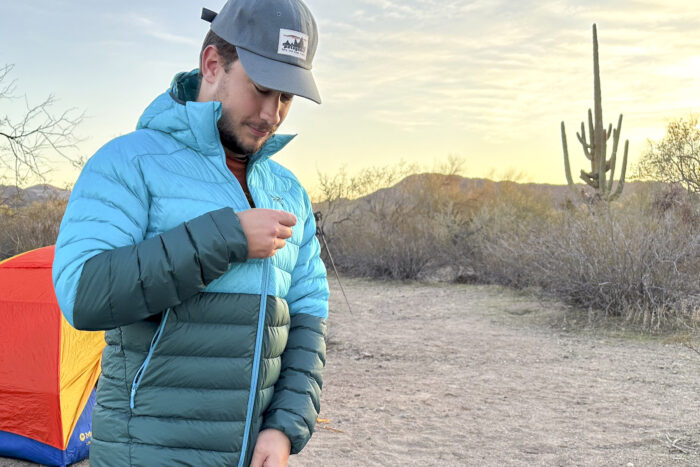
Cerium Hoody Fit
One of the big improvements Arc’teryx made with the updated Cerium Hoody had to do with the fit. With the previous Cerium, many reviewers complained of unpredictable sizing.
In a reply to a question on its website, Arc’teryx noted that the new Cerium has a revised fit. The Medium remained unchanged — however, “smaller sizes are now tighter and larger sizes are now looser,” it said.
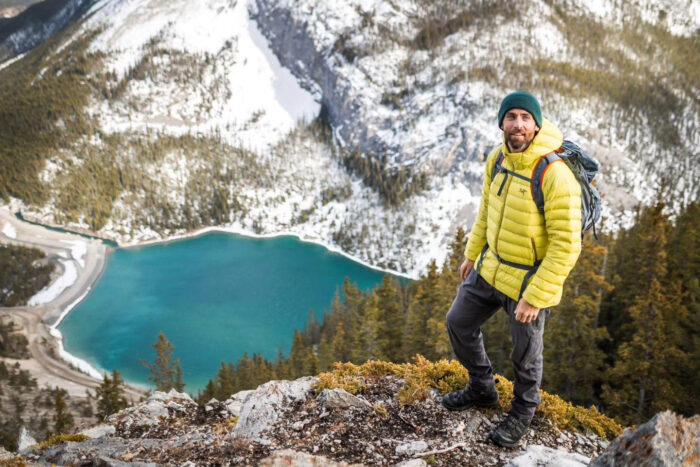
I’m glad the brand made this change. I always hovered between a Medium and Large in Arc’teryx jackets, with the former feeling too snug and the latter too loose.
Now, the Large feels more like a premium, slim-fitting garment. It’s an ideal choice for someone my size (5’11” and about 185 pounds). I also like that the tail is slightly longer than the front of the jacket, which helps prevent it from riding up when I sit down.
Important Features
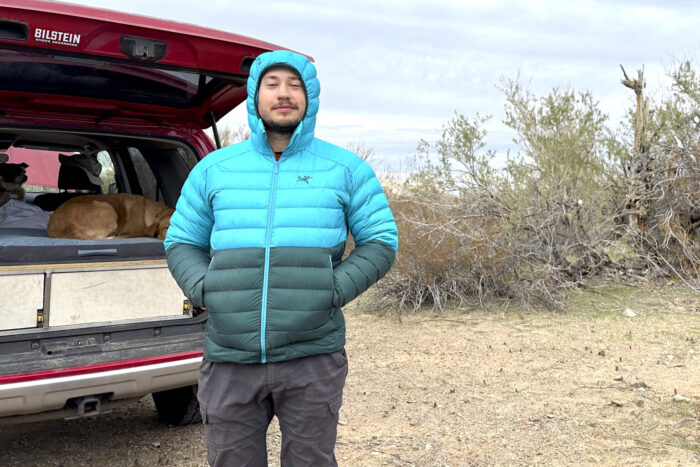
Down Composite Mapping
What stood out to me immediately about the Cerium was the strategically placed down and synthetic insulation. Cleverly, the brand utilizes both types of insulation to balance weight and warmth in wet conditions.
While the primary insulation is 850-fill fair-trade down, areas like the shoulders, underarms, and face are filled with Coreloft synthetic insulation. Arc’teryx calls it “Down Composite Mapping.”
The idea is to maintain warmth even if those specific areas get soaked with perspiration. In practice, this insulation system makes the Arc’teryx Cerium Down Hoodie a formidable technical jacket. It can be used for everything from rock and ice climbing to cold-weather backpacking.
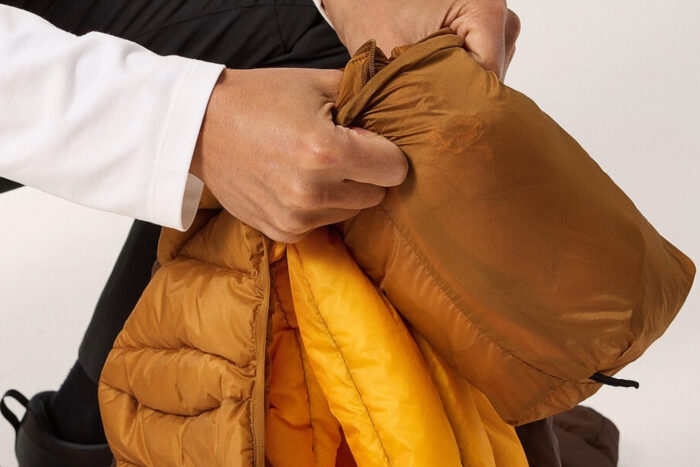
Packability and Pockets
The multi-fill construction also maintains great packability. Packed into its included stuff sack, it was just slightly larger than a 40-ounce water bottle.
Additionally, the three zippered pockets and cinchable hood and waist are all well-designed and effective.
This is a weird and particular note, but I love a slightly higher-up pocket to rest my arms in, which the Cerium Hoody provides.
The hood (Arc’teryx’s signature StormHood design), cinches super evenly. While camping, I tightened it up and the hood had an even seal around my head that didn’t shift, bunch up, or catch wind at all. Again, this is a technical feature of the jacket that is designed to work with helmets.
Arc’teryx Cerium Hoody: In the Field
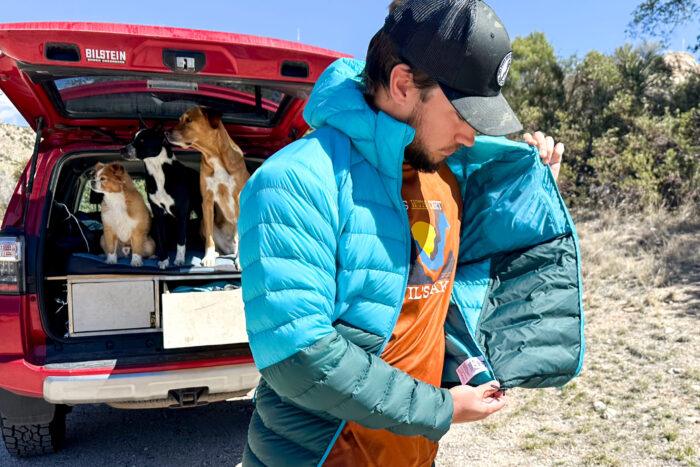
To get a true sense of the Cerium Hoody’s warmth capability I took the jacket out on a camping trip to Ironwood Forest National Monument just northwest of town. Lows hovered around freezing, and I got to break out the jacket before sunset. It kept me warm as I shot photos of pink and orange clouds hanging over Ragged Top Peak.
Later, back at camp, I set up a tent, built a fire, cooked dinner, and played fetch with the dogs. I was active and moving around and as warm as the Cerium Hoody felt, I never got overheated.
After dark the temps dropped and the weather turned for the worse. The wind picked up and moisture settled in, indicating rain the next day. I only took the jacket off when I was tucked into my sleeping bag for the night. It was comfortable and warm enough that I didn’t want to take it off.

Fabric Durability
Initially, I was worried about snags and tears in the jacket’s outer. Our campsite was nestled in a lush desert landscape filled with Palo Verde trees, Teddy Bear Chollas, and Saguaros. In other words, there were a lot of pokey things around.
Also, the Arc’teryx Cerium’s 15D face fabric is one of the finest deniers on our list of best down jackets. It’s finer than the oft-compared Patagonia Down Sweater’s 20D fabric. And I think it feels noticeably softer than the Patagonia as well.
However, this is an upgrade from the former 10D face fabric of the previous Cerium generation. And I was impressed with its durability. I inadvertently brushed against some Palo Verdes and creosote bushes and the shell fabric slid smoothly without catching or tearing. Obviously, it isn’t going to withstand any cactus I walk into. But it seemed to hold up well to general use and abuse.
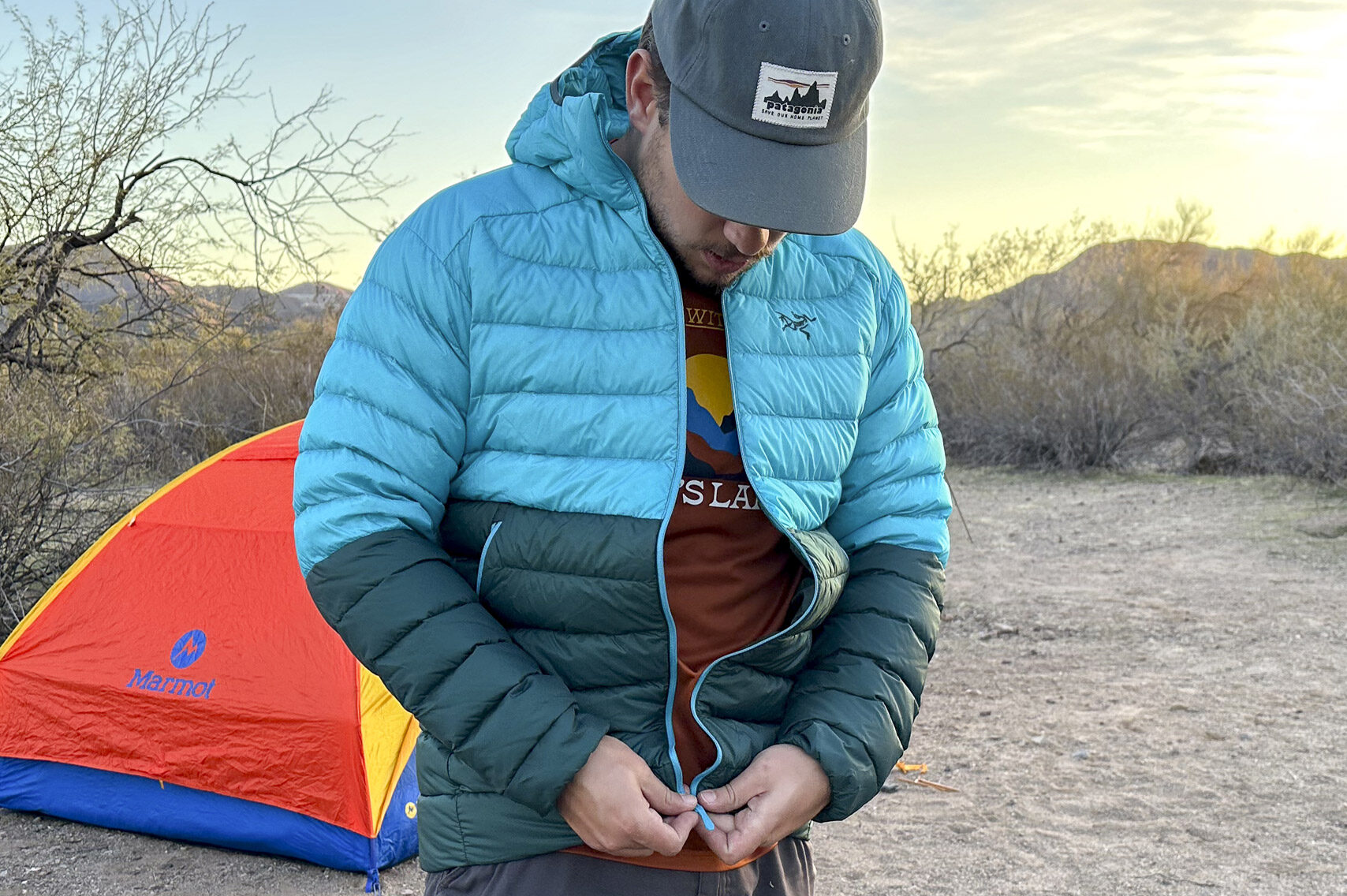
Insulation and Wind Protection
This was what fully sold me on the Arc’teryx Cerium Hoody. My go-to down jacket for nearly a decade has been the Patagonia Down Sweater. But as dependable as that jacket is, it always struggles in high winds. Maybe it’s the composite insulation, or the Cerium’s slightly higher down rating (850 versus 800). But the protection against 20+ mph winds felt refreshing in this down puffy.
Once I threw the hood up and cinched it down, I could tuck my hands in the well-placed pockets and feel completely warm and protected against any cold winter gusts of wind.
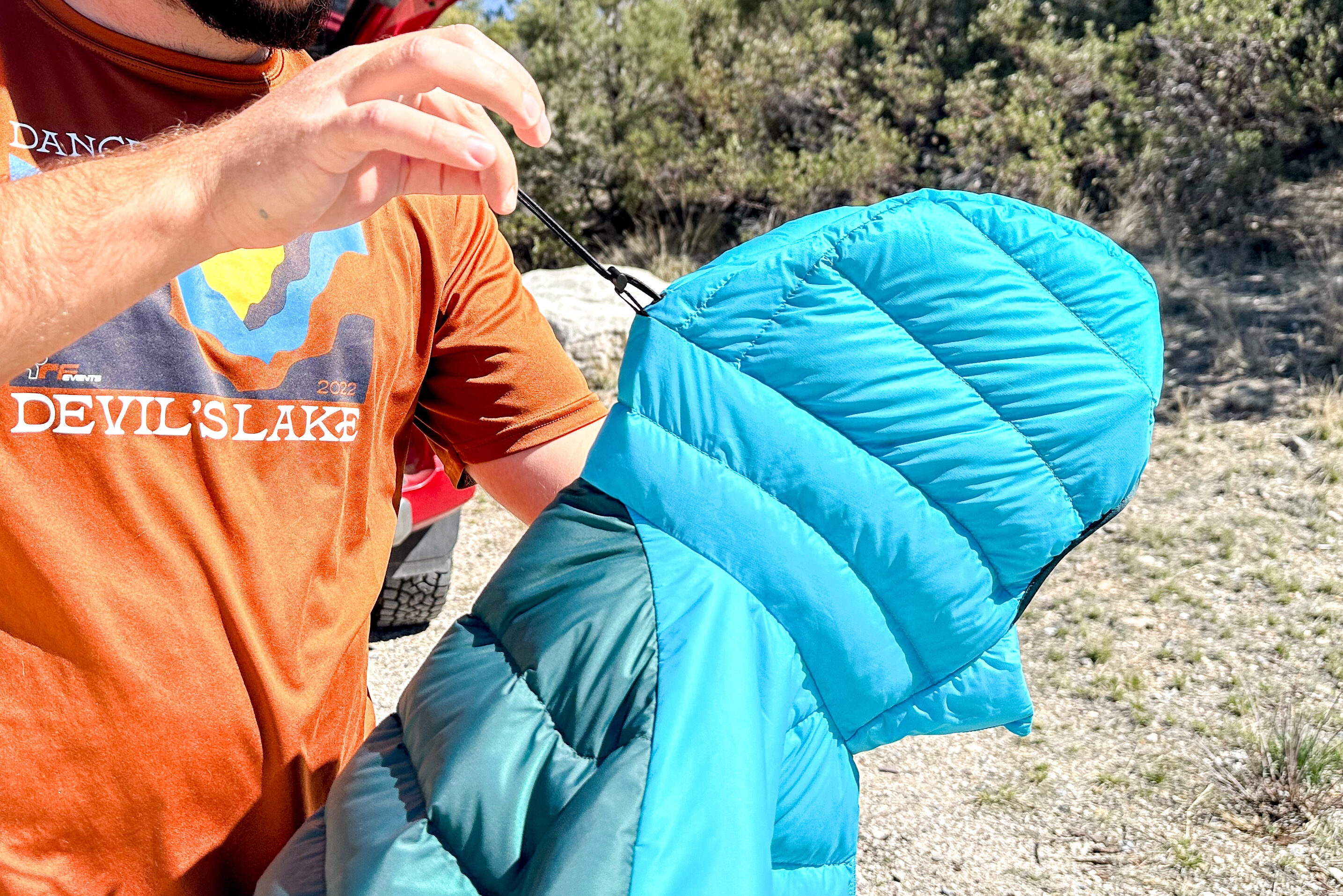
In the morning the wind was particularly cutting. As I snapped some photos of the sunrise, I wandered through the open landscape with the dogs. We walked a couple of miles in total, mostly making use of a cattle-frequented wash to duck below the wind.
Occasionally, the gusts would scream right down the wash but only my pants let the cold through. Back at camp, the rest of our crew was huddled around a fire: Secure in my warm down jacket, I was on breakfast duty.
Notes on Sustainability
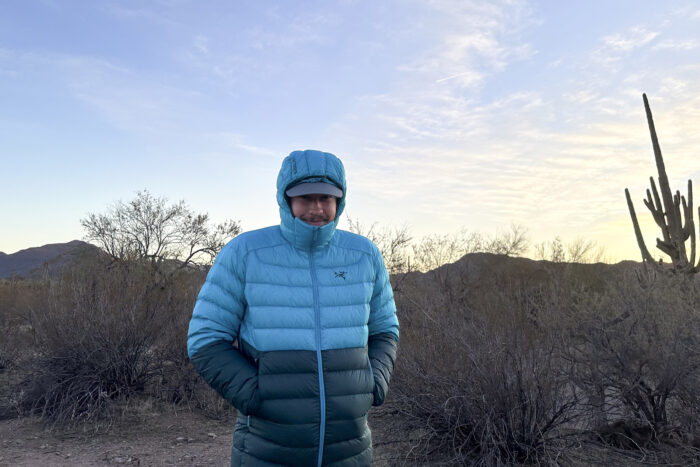
One of my favorite reasons for recommending the Cerium Hoody is the overall effort Arc’teryx has put in to make this product more sustainable. Progress toward sustainably made gear takes time. It feels like each season Arc’teryx makes is another leap toward a more eco-conscious future.
If you care strongly about your climate impact, the current Fair-Trade Certified Arc’teryx Cerium Hoody is one of the most sustainable jackets the brand has made. The outer material is fully recycled nylon. The water-repellent finish has no fluorocarbons in it. The down is responsibly sourced. And it dope-dyes its yarn, which uses fewer chemicals and energy to color textiles.
Arc’teryx has gone a long way to ensure this jacket has the smallest possible impact on the environment.
Arc’teryx Cerium Hoody: Bottom Line

Tucson’s winter cold streak could not have come at a better time. I got to put the Arc’teryx Cerium Hoody to the test frequently, and have now worn it on many a brisk morning dog walk, windy winter camping, and on a couple of cold-night brewery patios for good measure.
I’ve always been a fan of puffy jackets for their versatility: As far as a one-and-done jacket, the Cerium Hoody is the best I’ve ever worn. Under a waterproof shell, this would be an imperviously warm and protective layer.
The Arc’teryx jacket is great for truly cold winter adventures — especially those where you will be working up a sweat. It’s light and packable enough for backpacking and climbing. While $400 is no small investment, the Arc’teryx Cerium Hoody is a sustainably made, effective, and versatile jacket that will serve you well for years.
